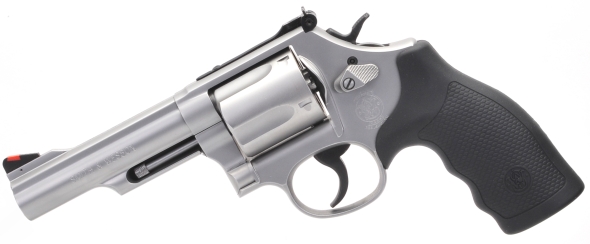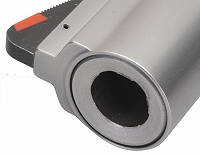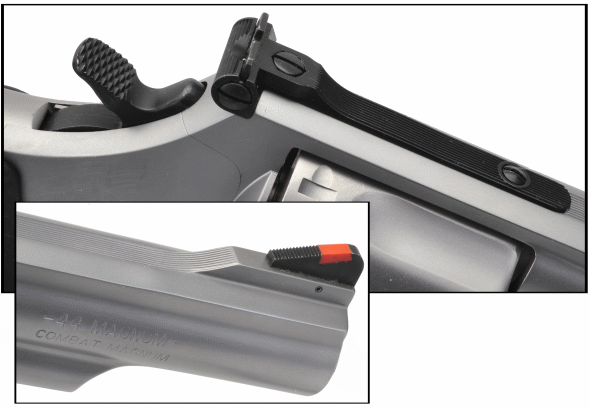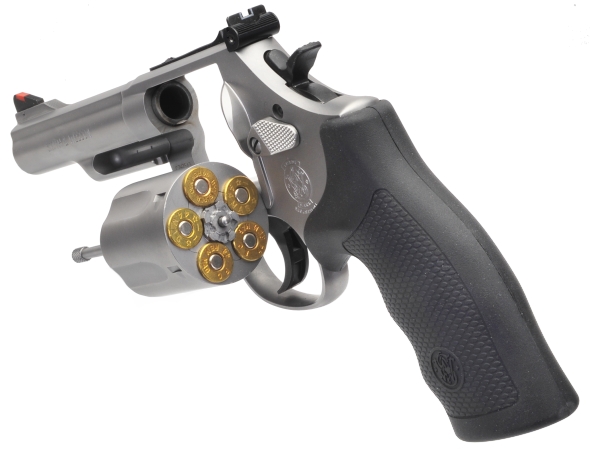
The original “Combat Magnum” was introduced as a lightweight 357 Magnum in 1955; built on a K Target frame, larger than a standard K Frame, but much lighter than the large N frame. In 1957, the Combat Magnum became the Model 19, which ran in production until 1999. During its production run, seventeen design changes were incorporated to enhance the model’s performance and durability.
The L frame was introduced in 1983 as the basis for models that could handle a steady diet of 357 magnum ammunition. Lighter and more compact than the N frame, larger than the K Target frame, the K frame cylinder window is 1.82″ x 1.48″ where the L frame window is 1.82″ x 1.60″. The L frame is the basis for Models 581, 586, 681, 686, and 696, as well as for a number of Scandium/Titanium alloyed models. The L frame, with some modifications, is the basis for the Model 69 44 Magnum.
 There are three basic changes made to accommodate the 44 Magnum Model 69 in comparison to other L frames. The most significant change is the 5 shot cylinder which thickens outer and adjacent walls and locates the cylinder notches between chambers.
There are three basic changes made to accommodate the 44 Magnum Model 69 in comparison to other L frames. The most significant change is the 5 shot cylinder which thickens outer and adjacent walls and locates the cylinder notches between chambers.
The barrel has been changed to a two piece assembly (left), a barrel and a shroud, with the interlocked shroud retained by the barrel. Finally, the ejector rod is solid; no more center pin and forward end detent ball. The detent ball has been moved to the cylinder crane, locked into a notch in the underlug.

The frame tab (1) locks into the shroud and the barrel secures the assembly, so regardless the motion required to set the barrel torque, the front sight remains centered to the frame. The ejector rod (2) is solid as it no longer receives the detent ball typically located as an assembly within the underlug. The spring loaded detent ball (3) is now located in the crane and it locks into the notch in the shroud (4). The result is fewer parts for improved reliability and the detent is located closer to the cylinder so there is less leveraged force applied. The cylinder chamfer is a nice touch for easing holstering.
The outlined square notch rear sight is windage and elevation adjustable. The front sight is raised and ramped with a bright , contrasting orange insert. Together they form a clean, sharp sight picture.

Below, from this angle the narrowness of the frame and grip is more apparent. A typical N frame 6 shot 44 Mag cylinder diameter is 1.700″, the Model 69 5 round cylinder is 1.560″. The N frame outer cylinder wall is approximately 0.035″ thicker than the L frame, but the L frame space between cylinders is approximately 0.040′ greater.

The grip is long so all fingers are comfortably supported and the material is soft and resilient. That said, I am not sure if a wider wood grip would dampen recoil more or just take away from the compact design of the Model 69. That should become evident during live fire.
General thoughts
|
Model 69 |
|
| Company | Smith & Wesson |
| Point of Manufacturer | Springfield, MA |
| SKU # | 162069 |
| Type of Action | DA/SA |
| Caliber | 44 Magnum |
| Capacity | 5 |
| Barrel Length | 4.25″ |
| Barrel Material | Stainless |
| Rifling Twist Rate | 1:18.75″ RH |
| Frame Material | Stainless |
| Cylinder Material | Stainless |
| Finish | Bead Blasted |
| Grips | Synthetic |
| Front Sight | Ramped, Orange Insert |
| Rear Sight | Adjustable W/E |
| Weight of Firearm | 37.2 |
| Overall Length | 9.75″ |
| Overall Height | 6.25″ |
| Width | 1.56 |
| Key Lock | Yes |
| CA Certified | Yes |
| MA Certified | Yes |
| MSRP | $849 |
The Model 69 is probably the easiest big bore to carry, at least that I’ve run across. It is thin… slab sided, and weight is about the same as a 1911 autoloader.
The Model 69 is plain, but not in a bad way, as the bead finish is appreciated. However, I have mixed feelings about the contrasting matte black hammer and trigger. Totally subjective opinion of aesthetics.
The 5 round capacity is not an issue. The 44 Magnum round is really not a human defense firearm as much as an excellent round for hunting or wilderness defense, Some folks would have others believe that every firearm selection should be predicated on defense against multiple assailants during a prolonged shootouts. Too many movies, too many video games.
Double action trigger pull was heavy, but manageable at just North of 11 Lbs.. Single action pull is light, just north of 4 Lbs. and minimal in travel. Personally, I do not shoot double action revolvers from a single action condition as this tends to defeat the point and pull the trigger benefit of a double action revolver.
That’s about it for now. Some ammunition is being assembled, some factory ammo set aside and we’ll take a look at the Model 69’s live fire performance. The assembly quality is very good; no factory handling blemishes, no sloppy fitting and smooth mechanical operation. The Model 69 is definitely a revolver that instills pride of ownership. A good foundation.

Email Notification